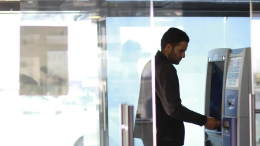On 21 November 2017, the United Nations Security Council will hold a debate on trafficking in persons in conflict.* Human trafficking is a recurring feature of contemporary armed conflicts, and a new report from Secretary-General António Guterres, requested by the Security Council last December and the basis for this upcoming debate, calls for more focus on preventing trafficking through stronger protection efforts and counter-criminal cooperation.
As we and others have argued previously, there is much the UN can do to address trafficking in conflict. Discussion to date has, however, risked missing half the equation: It is not just how conflict affects trafficking prevention efforts, but also how human trafficking drives conflict, that should be the focus of the Security Council’s attention.
As a result, the UN risks failing to recognize how anti-trafficking efforts – by the Security Council, but also through the UN’s work on migration – can help prevent conflict and sustain peace. This, despite the explicit request of the Security Council in Resolution 2331 (2016) that the Secretary-General integrate the issue of human trafficking “in conflict prevention strategies, conflict analysis, integrated missions’ assessment and planning [and] peacebuilding support.”
Trafficking from Libya to Europe, a route along which some of the most disturbing stories of trafficking-related crimes take place, offers a compelling case for why a “prevention first” approach to anti-trafficking is important. Drawing from this case, we aim to show what such an approach might look like, how it could usefully advance the Security Council’s upcoming debate, and more broadly how it could advance the Secretary-General’s prevention-driven reform agenda.
How trafficking affects conflict – the case of Libya
Human trafficking in Libya is sometimes represented in the media as a question of supply and demand: Traffickers and smugglers provide the supply (of irregular movement), while irregular migrants – and ultimately their employers and exploiters in Europe – create the demand. Through this lens, the key challenges are typically seen in terms of weak criminal justice mechanisms, focusing on the struggles of Libyan authorities to cut off the supply, and the challenges the international system faces in coordinating to hold perpetrators accountable or effectively protect the victims. Traditional approaches to tackling these issues predictably focus on strengthening national institutions, increasing international cooperation to hold perpetrators accountable, and putting in place better protection capabilities for victims.
This approach has merit. Surely increasing Libyan criminal justice capacities would have a positive impact, allowing the authorities to interdict more traffickers and hold them accountable, while also feeding a more nuanced and detailed understanding of what works best to disrupt trafficking routes. And targeted efforts to include human trafficking in the UN’s humanitarian cluster system will certainly improve the response for victims.
But as the Libya case highlights, human trafficking in conflict situations is not a simple equation of supply and demand; it is a far more complicated picture. Trafficking is deeply entwined with the conflict dynamics and post-revolution economy in Libya: it is a means through which armed militias engage in resource predation, offer socioeconomic and militarized protection to the communities they operate within, and expand their own political power. For example, as a prior UNU project has shown, previously marginalized groups like the Toubou and Amizagh have successfully used trafficking as a route to wealth and power, upsetting long-standing political configurations and driving new conflict risks in the country. Organized crime in Libya is not separate from politics; as has proven the case elsewhere, it is politics by other means.
Treating human trafficking as a deeply embedded feature of the political-economic landscape of Libya points to the need for a more wide-ranging response. Criminal justice and protection responses are needed, but these should be elements of a political strategy focused on stronger governance of migration, and supported by local, longer-term development activities. In short, we are advocating for the kind of bridging strategy between response and prevention that was envisioned by the Security Council and the General Assembly in their parallel “Sustaining Peace” resolutions – a strategy at the heart of the Secretary-General’s reform efforts.
This has at least three implications for how the Security Council approaches the question of the relationship between human trafficking and conflict:
First, human trafficking can be an entry point for understanding the underlying conflict. In Libya, for example, analysis of the ways in which trafficking sent ripples through existing power-sharing networks is important for understanding the drivers of violent conflict in the country. Understanding trafficking provides a crucial step towards managing, mitigating and preventing future conflict. But if the UN is to be serious about understanding human trafficking and its dynamic relationship with conflict, the UN—peace operations, Peace and Development Advisers and Headquarters—need expertise and guidance to read these illicit economic dynamics.
Second, this analysis shows that policy responses to trafficking must be framed locally, as Crisis Group has argued in its work on southwest Libya. In Libya and other conflict settings, trafficking is often driven by local communities’ sense of who protects them. If they find protection more reliably in the people we call “traffickers” than from state institutions, no amount of national-level institutional support will help. Indeed, the traditional macro-approach to trafficking – focused on development of the state’s criminal justice capacities – might gain a short-term win against a particular trafficking effort, but it will not deal with the structural incentives and power dynamics in the peripheries, where illicit markets thrive. As such, it is unlikely to stick.
Third, a local strategy must be connected to both a national and a transnational one. It is no accident that we see today’s conflicts frequently intersecting with human trafficking routes. Contemporary conflict and human trafficking are both fueled by often highly localized armed actors interacting with, taxing, trading through and otherwise drawing political legitimacy from transnational flows of people, weapons, goods and capital. Purely local or purely national political deals that fail to address these underlying flows and the way they incentivize and reward violent competition with the state – whether as rebellion or as crime – will not lead to sustained peace.
Governing migration to sustain peace
Human trafficking not only feeds the conflict cycles of countries like Libya, but is also crucial to understanding how migration policy can drive violent conflict. In the case of Libya, the lack of regular circuits for the movement of people into Europe has meant that irregular circuits flourish. Human traffickers – who already live along these illicit routes and are willing to use violence and corruption to achieve their goals – thrive in this environment. In this light, European attempts to suppress migration across the Mediterranean may in fact be a boon to human traffickers, as more would-be migrants are forced to choose illicit routes. Illegal profits gained from trafficking in turn fuel conflict, creating a vicious cycle.
Safe, orderly transit arrangements for migrants would not only address their immediate protection concerns, but would also undercut the human trafficking groups that are part of the conflict terrain in countries like Libya. They would transform the incentives those groups respond to, turning ‘uncivil society’ (in Secretary-General Annan’s phrase) into civil society and perhaps even into small business entrepreneurs as legitimate migration agents. A global compact on migration that tackles questions of irregular circuits and the role of developed economies in fueling trafficking would hence be a major step forward.
This may seem like a counterintuitive point – after all, a global compact would be generated by the General Assembly, not by the Security Council, and would not on its face be geared towards preventing violent conflict. And yet this is what integrated, systems-based and “prevention” thinking looks like: where a security problem results from deeper problems of governance or inequality, it may be upstream policy choices – not downstream fixes – that ultimately sustain peace.
Towards a more integrated approach
In Resolution 2331 (2016), the Security Council asked the Secretary-General to integrate the issue of human trafficking “in conflict prevention strategies, conflict analysis, integrated missions’ assessment and planning [and] peacebuilding support.” To achieve that, the Security Council will need to move beyond treating anti-trafficking efforts in narrow technical criminal justice or protection terms, and begin to see anti-trafficking efforts as an aspect of the larger push towards an integrated approach to conflict prevention.
Instead of seeing anti-trafficking tasks as another bauble to hang on missions’ Christmas tree mandates, the Council must see them as a way to understand and address the underlying drivers of ongoing crisis and violence. And instead of seeing anti-trafficking as the domain of the UN’s professional anti-traffickers, the Council must ask how an anti-trafficking lens can help all parts of the UN system work together to sustain peace.
Moving in this direction will require the Security Council to answer some practical – even operational – questions:
-
How can a better understanding of the dynamics of human trafficking help us understand the dynamics of armed conflict? Where can efforts to prevent trafficking create opportunities for conflict management and prevention?
-
Do mission and, where relevant, non-mission personnel have access to the requisite expertise (either in the field, or through support provided by or through headquarters) to analyze the dynamics of human trafficking markets?
-
What norms should guide UN actors’ engagement with groups or actors that are involved in human trafficking in conflict? In which cases do the norms that guide engagement with actors suspected of involvement in atrocity crimes come into play? How should UN personnel integrate the need for justice and accountability with other aspects of the UN mandate, such as conflict prevention and sustainable development?
-
How can missions alter the local incentive structures that foster armed groups’ participation in – and communities’ support for – human trafficking? What partnerships (i.e. with development actors, or private sector actors) may missions need to foster to put in place peacebuilding efforts that will lastingly disrupt these incentives, and sustain peace? What examples are there of success stories in transforming trafficking economies into economies based on licit livelihoods?
-
What policy choices at the transnational or international level can help encourage such local transformations? For example, how would bilateral or regional migration arrangements with Libya or other countries in the Sahel help establish safe, orderly and regular migration routes, and what impact would this have on trafficking organizations in Libya?
-
How can UN missions work with relevant UN system entities, such as the IOM, ILO, IFAD, FAO, or UNICEF to help individuals and communities disengage from human trafficking activities and find new, sustainable livelihoods?
-
And what rules govern military activity to protect civilians from human trafficking in conflict?
These are live questions not only in Libya, but in other conflict-affected settings, such as Colombia, DRC, Mali, Myanmar and Yemen. Should the UN’s presence in Syria grow, there is little question that these and related questions of armed groups’ involvement in illicit economies, will rear their heads quickly.
If we are serious about sustaining peace in these settings, the upcoming debate in the Security Council on human trafficking in conflict seems like a good moment to start to ask – and answer – these questions.
This post builds on earlier work at UN University, and also on discussions at a workshop with UN, state, civil society and research actors in New York in May 2017, organized with the support of the Permanent Mission of Liechtenstein to the United Nations, and subsequent research and consultations.
Suggested citation: Dr James Cockayne, Julie Opperman., "Can We Sustain Peace by Fighting Human Trafficking in Conflict? Lessons From Libya," UNU-CPR (blog), 2017-11-10, https://unu.edu/cpr/blog-post/can-we-sustain-peace-fighting-human-trafficking-conflict-lessons-libya.


